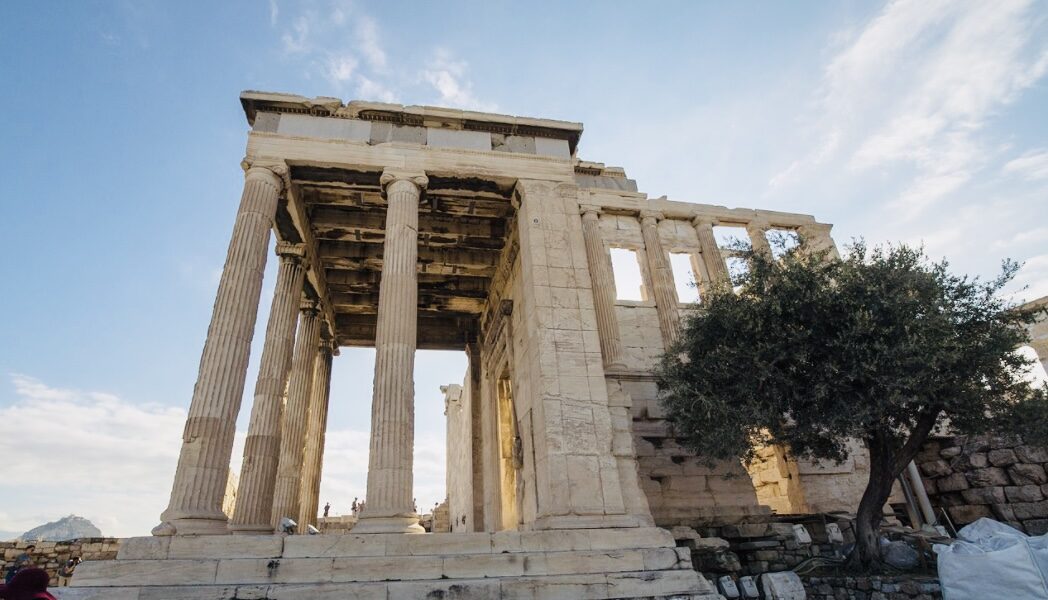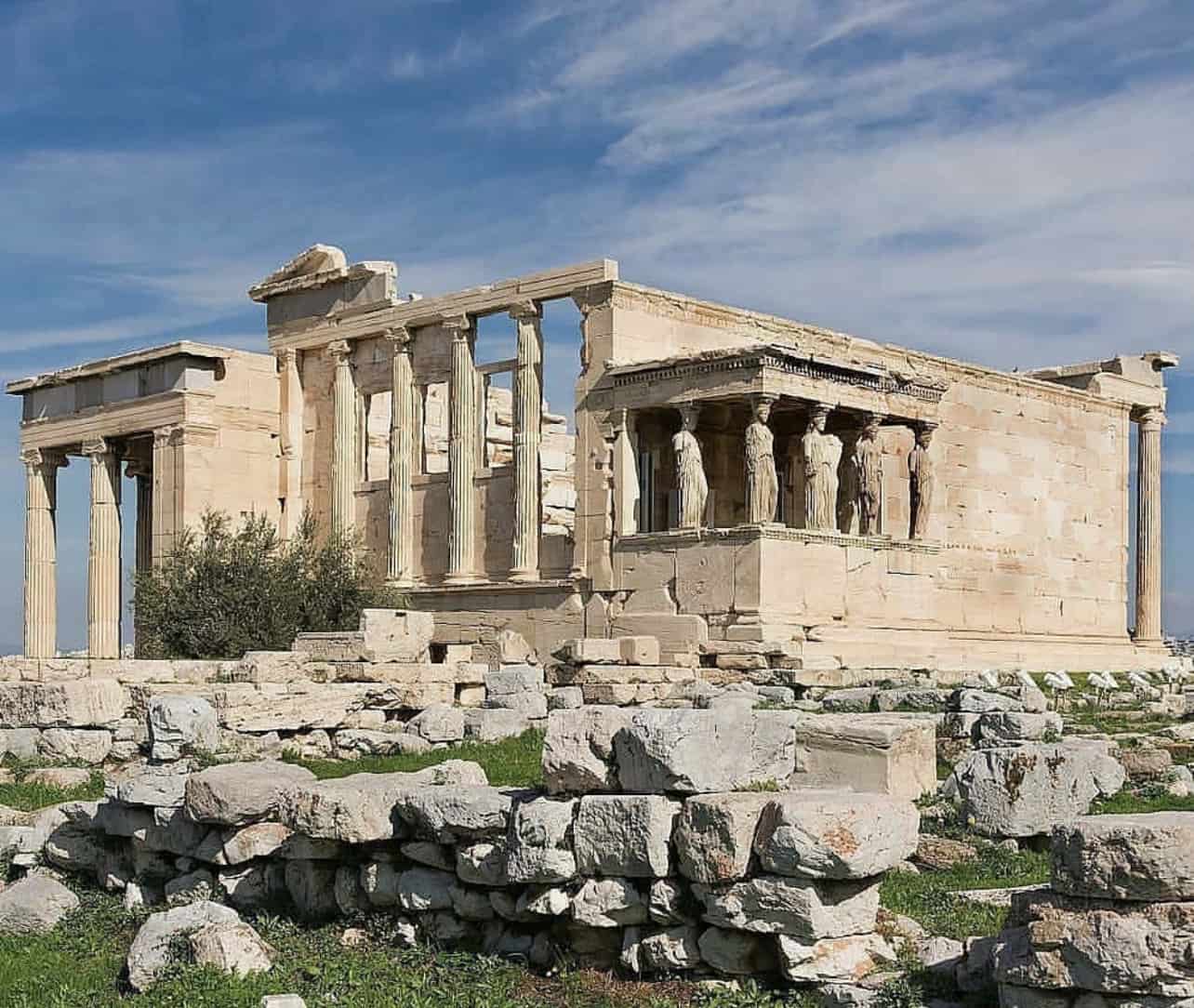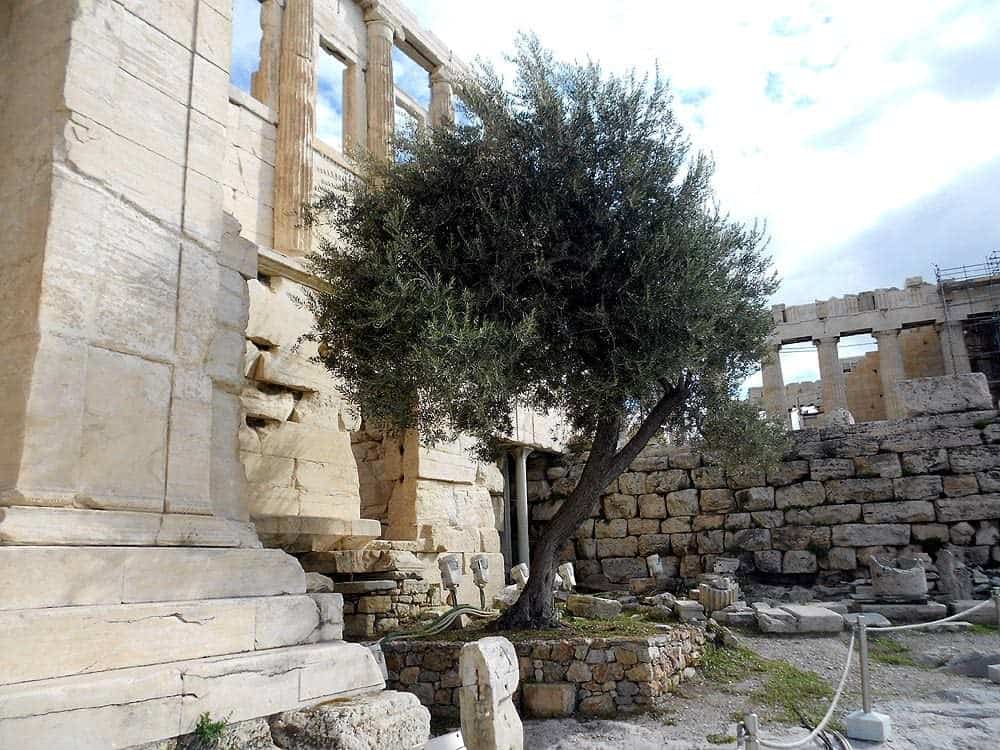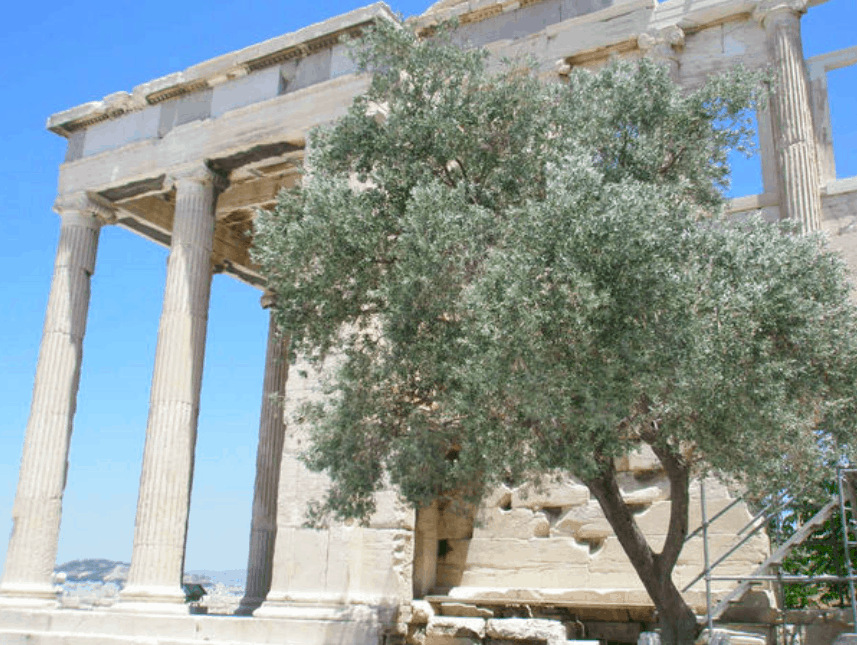by NATALIE MARTIN

In the heart of the Acropolis, there stands a sacred olive tree.
Over the centuries, the tree has endured wars, eternally surviving, or a branch has always been saved and replanted.
For over 2,500 years, the tree has remained a worthy symbol of Athens, an undying and ancient representation of prosperity, peace, hope, and resurrection.
The Acropolis Olive Tree and the Founding Myth of Athens
According to Greek mythology, the cherished tree of the Acropolis was planted by the Goddess Athena herself and is part of the founding myth of Athens.
Legend has it that Athena and Poseidon argued over the control of Athens, and so Zeus proposed a contest between them, deeming that city would be a prize to the winner.
Athena and Poseidon met on the hill of the Acropolis and Zeus, the Olympian gods, and the people of Athens gathered to witness the contest between the two great gods.

Poseidon struck his three-pronged trident upon the hard rock of the Acropolis, shaking the earth. An underground sea was created, unleashing a saltwater spring. However ancient Athens was a city with access to plenty of rivers and close to the sea; thus Poseidon’s gift was met with limited enthusiasm.
When it was Athena’s turn, she kneeled and planted something on the ground. Within minutes a fully grown olive tree rose from the earth, rich fruit bountifully adorning its branches. The tree, with its high-quality timber and an abundance of nutritional fruit that could also be used to make olive oil with multiple applications, was clearly the superior gift.
Proclaimed as the competition winner, Athena gave her name to the city, which was subsequently called Athens.
The dramatic showdown between the two mighty Olympians is immortalised in stone on the West pediment sculptures of the Parthenon.
While the tree now standing today may not be the original one, the foundation myth of Athens explains why it is held so sacredly, not just by Athenians, but by all Greeks.
History of the Acropolis Olive Tree
When the Great King Xerxes’ Persian armies swept through Greece and sacked Athens in 480BC, the buildings on the Acropolis and the sacred olive tree were set on fire and destroyed.
Despite this, ancient Greek writer and geographer Herodotus claimed that olive tree “sprouted the same day to a height of two cubits” – or around 1 metre. This new growth symbolised hope and the quick recovery of Athenians in the face of adversity.
Seeds from the remnants of this tree were replanted across Attica. Therefore it is commonly believed that all of the olive groves surrounding Athens have a trace of Athena’s original tree in them.

Between 421 and 406 BC, the Erechtheion was built to house the most sacred areas of the Acropolis. It created a precinct for some of the most ancient and holy relics of the Athenians including the beloved olive tree planted by Athena, the Palladion (a xoanon, or olive wood carved effigy of Athena), the marks of Poseidon’s trident, and the Erechtheis (the saltwater well that resulted from Poseidon’s strike).
Once again, the olive tree regained grand monuments in its vicinity and continued to be honoured as a focal part of the Athenian religious and cultural landscape for centuries to come.
The tree has suffered many fires and mutilations as invaders have come and gone.
But a sprig was always saved to be planted later.
Most recently, members of the American School of Archaeology in 1952 replanted the tree with a branch that had been saved and harvested following the destruction caused by the Germans during World War II.


In the heart of the Acropolis, there stands a sacred olive tree.
Over the centuries, the tree has endured wars, eternally surviving, or a branch has always been saved and replanted.
For over 2,500 years, the tree has remained a worthy symbol of Athens, an undying and ancient representation of prosperity, peace, hope, and resurrection.
The Acropolis Olive Tree and the Founding Myth of Athens
According to Greek mythology, the cherished tree of the Acropolis was planted by the Goddess Athena herself and is part of the founding myth of Athens.
Legend has it that Athena and Poseidon argued over the control of Athens, and so Zeus proposed a contest between them, deeming that city would be a prize to the winner.
Athena and Poseidon met on the hill of the Acropolis and Zeus, the Olympian gods, and the people of Athens gathered to witness the contest between the two great gods.

Poseidon struck his three-pronged trident upon the hard rock of the Acropolis, shaking the earth. An underground sea was created, unleashing a saltwater spring. However ancient Athens was a city with access to plenty of rivers and close to the sea; thus Poseidon’s gift was met with limited enthusiasm.
When it was Athena’s turn, she kneeled and planted something on the ground. Within minutes a fully grown olive tree rose from the earth, rich fruit bountifully adorning its branches. The tree, with its high-quality timber and an abundance of nutritional fruit that could also be used to make olive oil with multiple applications, was clearly the superior gift.
Proclaimed as the competition winner, Athena gave her name to the city, which was subsequently called Athens.
The dramatic showdown between the two mighty Olympians is immortalised in stone on the West pediment sculptures of the Parthenon.
While the tree now standing today may not be the original one, the foundation myth of Athens explains why it is held so sacredly, not just by Athenians, but by all Greeks.
History of the Acropolis Olive Tree
When the Great King Xerxes’ Persian armies swept through Greece and sacked Athens in 480BC, the buildings on the Acropolis and the sacred olive tree were set on fire and destroyed.
Despite this, ancient Greek writer and geographer Herodotus claimed that olive tree “sprouted the same day to a height of two cubits” – or around 1 metre. This new growth symbolised hope and the quick recovery of Athenians in the face of adversity.
Seeds from the remnants of this tree were replanted across Attica. Therefore it is commonly believed that all of the olive groves surrounding Athens have a trace of Athena’s original tree in them.

Between 421 and 406 BC, the Erechtheion was built to house the most sacred areas of the Acropolis. It created a precinct for some of the most ancient and holy relics of the Athenians including the beloved olive tree planted by Athena, the Palladion (a xoanon, or olive wood carved effigy of Athena), the marks of Poseidon’s trident, and the Erechtheis (the saltwater well that resulted from Poseidon’s strike).
Once again, the olive tree regained grand monuments in its vicinity and continued to be honoured as a focal part of the Athenian religious and cultural landscape for centuries to come.
The tree has suffered many fires and mutilations as invaders have come and gone.
But a sprig was always saved to be planted later.
Most recently, members of the American School of Archaeology in 1952 replanted the tree with a branch that had been saved and harvested following the destruction caused by the Germans during World War II.

The symbolism of the Olive Tree
Since ancient times, the olive tree has remained a central part of Greek life, cherished for all of its profound qualities.
Whilst the olive tree atop the Athenian Acropolis may have held extra importance to Greeks compared to others due to its divine provenance, olive trees have been treasured by civilisations for thousands of years.
The olive tree symbolises peace, wisdom, fertility, prosperity, health, luck, victory, stability and tranquillity.
Noah’s dove carried an olive branch in its mouth, signifying the salvation of life on earth after the great flood as detailed in The Book of Genesis.
Olive leaves have crowned the heads of victorious Olympic athletes, Generals and Kings.
Olive wood has been used to construct houses and boats.
Olive oil and olives, the fruit of the olive tree, are staples of the Mediterranean diet and a valuable export throughout antiquity and to this day.
The olive tree loves the sea and the Mediterranean sun, it grows even on arid and rocky soils and it survives under droughts and strong winds.
It has accompanied Greeks through times of both prosperity and adversity, leaving its imprint in every aspect of Greek cultural tradition.
Perhaps then it is only fitting that it is at the Acropolis – one of the brightest jewels in humankind’s treasury – that the most cherished olive tree of all time is planted.


Since ancient times, the olive tree has remained a central part of Greek life, cherished for all of its profound qualities.
Whilst the olive tree atop the Athenian Acropolis may have held extra importance to Greeks compared to others due to its divine provenance, olive trees have been treasured by civilisations for thousands of years.
The olive tree symbolises peace, wisdom, fertility, prosperity, health, luck, victory, stability and tranquillity.
Noah’s dove carried an olive branch in its mouth, signifying the salvation of life on earth after the great flood as detailed in The Book of Genesis.
Olive leaves have crowned the heads of victorious Olympic athletes, Generals and Kings.
Olive wood has been used to construct houses and boats.
Olive oil and olives, the fruit of the olive tree, are staples of the Mediterranean diet and a valuable export throughout antiquity and to this day.
The olive tree loves the sea and the Mediterranean sun, it grows even on arid and rocky soils and it survives under droughts and strong winds.
It has accompanied Greeks through times of both prosperity and adversity, leaving its imprint in every aspect of Greek cultural tradition.
Perhaps then it is only fitting that it is at the Acropolis – one of the brightest jewels in humankind’s treasury – that the most cherished olive tree of all time is planted.


No comments:
Post a Comment